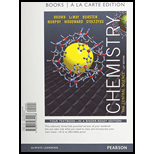
Concept explainers
In the ionic compounds LiF, NaCl, KBr, and RbI, the measured cation-anion distances are 2.01 Å (Li—F), 2.82 Å(Na-CI), 3.30 Å (K-Br), and 3.67 Å (Rb-l), respectively.(a) Predict the cation—anion distance using the values of ionic radii given in Figure 7.8. (b) Calculate the difference between the experimentally measured ion—ion distances and the onespredicted from Figure 7.8. Assuming we have an accuracy of0.04 Å in the measurement, would you say that the two sets of ion—ion distances are the same or not? (c) What estimates of the cation—anion distance would you obtain for these fourcompounds using bonding atomic radii? Are these estimates as accurate as the estimates using ionic radii?
Want to see the full answer?
Check out a sample textbook solution
Chapter 7 Solutions
Chemistry: The Central Science, Books a la Carte Edition & Modified Mastering Chemistry with Pearson eText -- ValuePack Access Card Package
- Give the chemical formula for (a) chlorite ion, (b) chlorideion, (c) chlorate ion, (d) perchlorate ion, (e) hypochlorite ion.arrow_forwardSilicon is the foundation of today's Microelectronics.a) Indicate which other elements from group IV of the periodic table find applications in electronics, pointing out their usefulness.b) Similarly, composite materials using elements from groups III-V are widely used. Name at least 3 of these compounds, exemplifying their respective applications.arrow_forwardAmong Cl-, Ar, K+, Ca2+, Br-, Kr, Rb+, and Sr2+, which one has the largest radius?arrow_forward
- Select the lesser of each of the following pairs of radii. The covalent radius of Ga The covalent radius of Br The ionic radius of Rb+ The ionic radius of Sr2+ The ionic radius of Cl- The ionic radius F- The covalent radius of Si The covalent radius of C The metallic radius of Ca The metallic radius of Mgarrow_forwardWould you expect manganese(II) oxide, MnO, to react morereadily with HCl(aq) or NaOH(aq)?arrow_forwardWhich of the following elements would you expect to have similar properties? As Te Ar Sn Hearrow_forward
- The monatomic ions of Groups 1A(1) and 7A(17) are allsingly charged. In what major way do they differ? Why?arrow_forwardWrite the balanced chemical equation for the reaction of solid lithium with liquid water?arrow_forwardConsider the Mg2+, Cl-, K+, and Se2- ions. The four spheresbelow represent these four ions, scaled according to ionic size.(a) Without referring to Figure 7.8, match each ion to its appropriatesphere. (b) In terms of size, between which of the sphereswould you find the (i) Ca2 + and (ii) S2 - ions? [Section 7.3]arrow_forward
- Differentiate between metal and non-metal on the basis of their chemical properties.arrow_forwardArrange the following in increasing order of the indicated property: A. Mg²⁺, Na⁺, O²⁻ Ionic radius B. F, Cl, Br Electron affinity C. Be, B, Mg Nonmetallic property D. Co⁺, Co²⁺, Co³⁺ Ionization energy E. Al, Cl, P Diamagnetism F. P, F, K Electronegativityarrow_forwardWhich of the four atoms Na, P, Cl, or K (a) has the largest atomic radius? (b) has the highest ionization energy? (c) is the most electronegative?arrow_forward
 Chemistry & Chemical ReactivityChemistryISBN:9781337399074Author:John C. Kotz, Paul M. Treichel, John Townsend, David TreichelPublisher:Cengage Learning
Chemistry & Chemical ReactivityChemistryISBN:9781337399074Author:John C. Kotz, Paul M. Treichel, John Townsend, David TreichelPublisher:Cengage Learning Chemistry & Chemical ReactivityChemistryISBN:9781133949640Author:John C. Kotz, Paul M. Treichel, John Townsend, David TreichelPublisher:Cengage Learning
Chemistry & Chemical ReactivityChemistryISBN:9781133949640Author:John C. Kotz, Paul M. Treichel, John Townsend, David TreichelPublisher:Cengage Learning Introduction to General, Organic and BiochemistryChemistryISBN:9781285869759Author:Frederick A. Bettelheim, William H. Brown, Mary K. Campbell, Shawn O. Farrell, Omar TorresPublisher:Cengage Learning
Introduction to General, Organic and BiochemistryChemistryISBN:9781285869759Author:Frederick A. Bettelheim, William H. Brown, Mary K. Campbell, Shawn O. Farrell, Omar TorresPublisher:Cengage Learning Chemistry: Principles and PracticeChemistryISBN:9780534420123Author:Daniel L. Reger, Scott R. Goode, David W. Ball, Edward MercerPublisher:Cengage Learning
Chemistry: Principles and PracticeChemistryISBN:9780534420123Author:Daniel L. Reger, Scott R. Goode, David W. Ball, Edward MercerPublisher:Cengage Learning Chemistry: Principles and ReactionsChemistryISBN:9781305079373Author:William L. Masterton, Cecile N. HurleyPublisher:Cengage Learning
Chemistry: Principles and ReactionsChemistryISBN:9781305079373Author:William L. Masterton, Cecile N. HurleyPublisher:Cengage Learning





